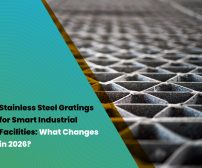If you’re planning a construction project in India, it’s important to choose the right metal grating material for the job. Metal grating is a versatile and durable material that is commonly used for walkways, flooring, and other applications. However, not all metal grating materials are created equal, and selecting the wrong one can lead to safety hazards, increased maintenance costs, and even project delays. In this article, we’ll explore the key factors to consider when choosing a metal grating material for your project in India.
Types of Metal Grating Materials:
Before diving into the selection process, it’s important to understand the different types of metal grating materials that are available in India. The most common materials include steel, aluminum, and stainless steel, each of which has its own unique set of benefits and drawbacks.
Steel:
Steel is a popular choice for its strength, durability, and affordability. However, it’s susceptible to corrosion and requires regular maintenance to prevent rust and deterioration.
Aluminum:
Aluminum is a lightweight and corrosion-resistant material that is ideal for outdoor applications. However, it is not as strong as steel and may not be suitable for heavy-duty projects.
Stainless steel (SS):
Stainless steel is a strong and corrosion-resistant material that is well-suited for industrial and marine environments. However, it is more expensive than other materials and may not be necessary for less demanding projects.
Environmental Factors:
The environmental conditions of your project site should also play a significant role in the selection of your metal grating material. India has a diverse climate, ranging from hot and humid in the southern regions to cold and dry in the northern regions. Additionally, certain areas may be exposed to corrosive elements, such as saltwater or acidic chemicals.
When selecting a metal grating material, it’s important to consider these factors and choose a material that can withstand the environmental conditions of your project site. For example, stainless steel may be a better choice for coastal regions that are exposed to saltwater corrosion, while aluminum may be suitable for hot and humid regions.
Load Requirements:
Load capacity is another important consideration when choosing a metal grating material for your project. Different materials have different load capacities, and selecting the wrong material can compromise the safety and integrity of your structure.
To determine the load capacity requirements of your project, consider factors such as foot traffic, machinery weight, and potential impact loads. For heavy-duty projects, steel or stainless steel may be the best option, while lighter projects may be able to use aluminum or other lightweight materials.
Cost Considerations:
Cost is always a consideration when choosing construction materials, and metal grating is no exception. The cost of metal grating materials can vary significantly depending on the material type, size, and thickness.
When selecting a metal grating material, it’s important to balance cost considerations with other factors such as environmental conditions and load requirements. While cheaper materials may seem like a cost-effective option, they may not be able to withstand the demands of your project site and may require more frequent maintenance or replacement in the long run.
Maintenance Requirements:
Finally, it’s important to consider the maintenance requirements of different metal grating materials when making your selection. Different materials have different maintenance needs, and failing to properly maintain your metal grating can compromise its safety and integrity.
For example, steel grating requires regular cleaning and rust prevention measures to prevent corrosion and deterioration. Aluminum grating, on the other hand, requires little maintenance beyond occasional cleaning to remove debris and dirt.
Conclusion:
Choosing the right metal grating material is essential for any construction project in India. By considering factors such as material type, environmental conditions, load requirements, cost, and maintenance needs, you can ensure that your metal grating is durable, safe, and cost-effective in the long run. Remember to consult with a professional to help determine the best metal grating material for your specific project needs. With the right material, your construction project will be off to a strong start and have the foundation it needs for success. For high-quality and customized solutions, connect with Grating manufacturers in Vadodara, Ankleshwar, or Dahej for reliable, long-lasting metal grating materials.






